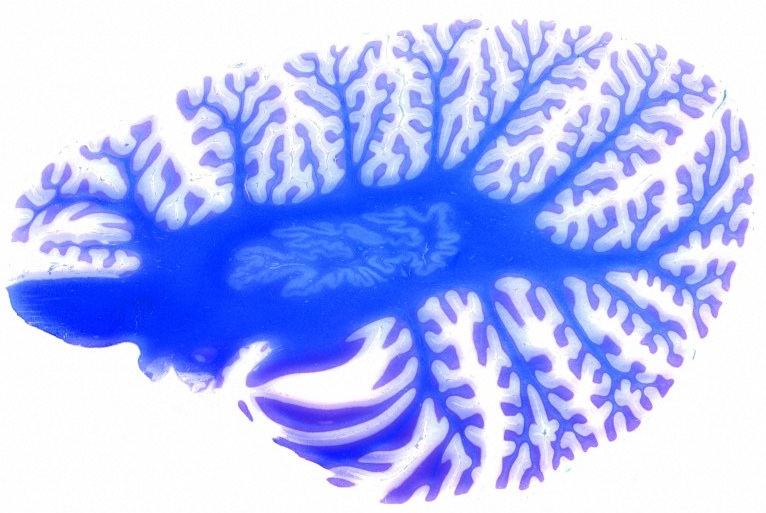Bone metastasis tied to ‘Tie2’
When breast cancer spreads to bone, as it often does, the cancer cells hijack the normal bone growth process, abnormally activating osteoclasts – cells that break down bone – and releasing growth factors that promote tumor survival. Understanding this cycle of tumor-induced osteolysis is critical for combating bone metastasis.
Previously, Charles Lin, Ph.D., and colleagues showed that Tie2, a receptor tyrosine kinase, is increased in human breast cancers and that the protein regulates the growth of tumor blood vessels (angiogenesis). Now, in studies led by Yongfen Min, M.D., Ph.D., they show that Tie2 also plays important roles in the development of bone-degrading cells (osteoclasts) and in bone invasion of breast tumors in mice.
In the April 1 issue of Cancer Research, they report that eliminating Tie2 function impairs the development of osteoclasts in a cell-based assay. And in a mouse model of breast cancer, they found that neutralizing Tie2 activity significantly inhibits osteolytic bone invasion and tumor growth. The findings suggest that drugs targeting Tie2 activity could hold promise for treating or preventing breast cancer bone metastasis.
— Melissa Marino
Sonic hedgehog spurs neuron growth
The cerebellum – the “little brain” tucked at the base of the brain – plays important roles in motor coordination and sensory perception. These functions depend on diverse cerebellar cell types that originate during embryonic development from two distinct cell layers – the rhombic lip and the ventricular zone (VZ).

Wellcome Images
Chin Chiang, Ph.D., and colleagues are exploring the signaling mechanisms that maintain the proliferative capacity of the VZ – its ability to continuously “give birth” to neurons as the cerebellum develops. They report in the May 4 Proceedings of the National Academy of Sciences that the signaling molecule Sonic hedgehog (Shh) is active in the VZ and is essential for the proliferation and expansion of multiple types of cerebellar neurons. They demonstrate that the cerebellum does not produce Shh; instead Shh appears to be delivered across the VZ by the cerebrospinal fluid. The findings suggest that VZ cells may play a role in the pathogenesis of cerebellar diseases associated with deregulated Shh signaling, such as medulloblastoma.
— Leigh MacMillan
Putting DAT in reverse
The neurotransmitter dopamine modulates brain circuits involved in motor activity, attention and reward. Disrupted dopamine signaling has been implicated in brain disorders including Parkinson’s disease and attention-deficit hyperactivity disorder (ADHD).

Wellcome Images
222
The findings in the April 28 Journal of Neuroscience suggest that mutations in other genes – such as CaMKII or D2R – could potentially trigger ADE and represent a source of risk for mental illness.
— Leigh MacMillan
Cartilage development gets fishy
Mutations that disrupt protein trafficking in the cell – and cause misshapen “faces” in zebrafish embryos – may hold clues to craniofacial birth defects and degenerative cartilage diseases in humans.

Screening for mutations in zebrafish, Ela Knapik, M.D., and colleagues have identified a mutant, called bulldog, which results in fish embryos with shortened bodies, deformed heads and kinked pectoral fins. The investigators determined that the defects were due to mutations in the gene encoding Sec24D, an adaptor protein involved in transporting proteins synthesized in the endoplasmic reticulum to the cell surface.
Investigating the cellular impact of these mutations, they found that cartilage-producing cells from these mutants fail to secrete type II collagen and other components of the extracellular matrix, suggesting an essential role for Sec24D in the secretion of cartilage matrix proteins. The results reported in PLoS ONE reveal an important developmental role for Sec24D and suggest that this gene may be a strong candidate in cartilage disorders and craniofacial birth defects.
— Melissa Marino
We welcome suggestions for research to highlight in Aliquots. The items should be primary research articles (no reviews, editorials or commentaries) published within the last two months in a peer-reviewed journal. Please send the article citation (PDF if available) and any other feedback about the column to: aliquots@vanderbilt.edu.
Past Aliquots
June 22, 2012
June 8, 2012
May 11, 2012
April 27, 2012
April 13, 2012
March 30, 2012
March 16, 2012













